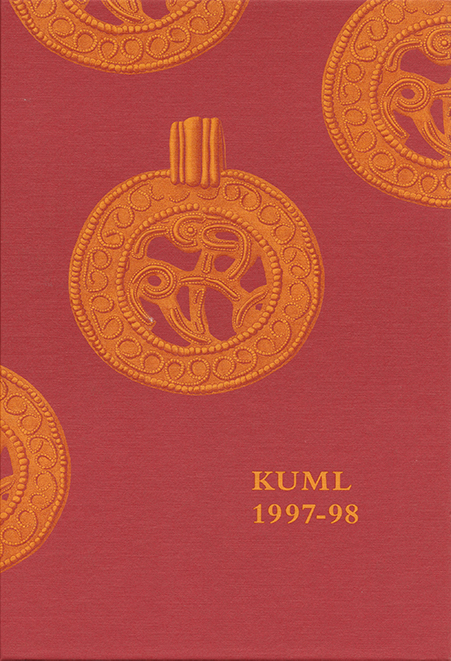A Magnificent ornamented axe from the Early Ertebølle Period
DOI:
https://doi.org/10.7146/kuml.v41i41.113360Keywords:
Ornamented axe, early ertebølle period, Mesolithic, antler axe, geometric pattern, ornamented, skærbæk, jutland, red deer, flint dagger, flynderhageAbstract
A magnificent ornamented axe from the Early Ertebølle Period
Even in Denmark, Mesolithic antler axes with geometric patterns covering the whole surface are a rarity. The ornamented tools from the Early Ertebølle Period in Western Denmark have been published previously (S. H. Andersen 1981), and this article should be considered a supplement to this past work.
The axe shown in fig. 1 was excavated from a sub-marine Culture layer at Skærbæk in Eastern Jutland, fig. 7. Consequently, it is a settlement find. The raw material is red deer antler. The axe had been scraped completely smooth and then given a geometric ornamentation covering the whole surface. The main part of the ornamentation had been scratched in a fine and thin line, but a small part had been carried out as a wider and coarser line. The coarser ornamentation is secondary, as it covers the fine line. Ornamentation carried out in two phases has been recorded previously on several other antler axes from Jutland from the Ertebølle Period.
The dominant motif is a regular chessboard pattern, which is repeated in different variations, fig. 1. Analysis of the ornamentation shows -as is the case for several other Danish antler axes- that it was not carried out at the same time but over a considerable period. On the axe from Skærbæk at least 15 different "pattern episodes" can be identified, which partly overlap and therefore must represent a quite long "pattern making period", fig. 2. This theory is supported by the fact that the axe is very polished with use and tremendous grinding.
The net motif is a characteristic ornament of the Early Ertebølle Period, but it is usually carried out in a rhomboid pattern. The regular chessboard ornament on the Skærbæk axe is rare. The other motifs are known from other Jutland antler axes.
According to type, ornamentation and find circumstances, the Skærbæk axe can be dated to the Early Ertebølle Period, c. 5400- 4700 BC. This date matches other finds of ornamented Ertebølle axes in Western Denmark (S. H. Andersen 1981).
Ornamented antler axes are known from several sires in East Jutland, fig. 7, but the surface-covering ornamentation and its regularity makes the Skærbæk axe unusual. This axe belongs to a small "exclusive" group of a few Danish, ornamented antler axes from the Late Mesolithic Ertebølle period. They are characterised partly by their surface-covering ornamentation, made in several phases over a long period, using different techniques and compositions, fig.3. A few similar axes are known from Zealand, but none from Northern Germany.
These axes are thought of as ritual objects, but the wear and grinding shows that they were also used in the everyday life.
In spite of the huge difference in space and time, the procedure of successively adding to or covering motifs on the surface of these axes is a clear analogue to the ornamentation of Southwest European caves from the late Ice Age, in which a similar procedure may be observed. The Danish Late Mesolithic antler axes and the cave art presumably reflect a similar ritual backdrop and "function". The vast majority of the West Danish finds of ornamented antler axes are from Eastern Jutland, fig. 7, which probably mirrors a regional character of the cultural conditions of this region during the early Ertebølle Period.
An important parallel to the Skærbæk axe is a recently found, ornamented antler axe from an Ertebølle grave at Fannerup on Djursland, fig. 4. Here, too, we are dealing with a completely worn axe with surface ornamentation, the motifs of which are similar to both the Skærbæk axe and the previously published axe from Bogø Nor (S. H. Andersen 1981). The Fannerup axe is important as it shows that ornamented antler axes do not just occur as single finds or in settlement sites but are also part of a ritual context connected to the grave cult. Another recently found ornamented antler axe comes from the kitchen midden "Nederst", fig. 5. It is ornamented with finely scratched rhomboids -a motif known from other, earlier finds of ornamented antler axes from the Early Ertebølle culture and which provides a link with the other East Jutland finds with this motif, fig. 7. Finally, an axe from the Ertebølle site "Korsør Nor" (Southwest Zealand) has been published. This axe also has a scratched "sheaf pattern". This is an important find, as it is the first time this pattern occurs in a settlement East of Storebælt, which has hitherto been the border of the distribution area of this motif, fig. 7. The axe from Korsør Nor may be interpreted in two ways: either the sheaf motif had a larger distribution in Denmark during the Early Ertebølle Period than that which has hitherto been assumed, or it represents an example of contact (exchange) between Ertebølle groups west and east of the Storebælt respectively.
Finally, a revised dating of the flint-edge dagger from Flynderhage is given, fig. 9. This knife has previously been dated to the late Kongemose Culture. However, in the light of the latest published curves of the coast line displacements during the Early Stone Age and several recent finds, for instance from the kitchen midden of "Sølager" and grave 4 from Bøgebakken, fig. 10 and 11, it must be re-dated to the Early Ertebølle Culture.
Søren H. Andersen
Downloads
Published
How to Cite
Issue
Section
License
Fra og med årgang 2022 er artikler udgivet i Kuml med en licens fra Creative Commons (CC BY-NC-SA 4.0).
Alle tidligere årgange af tidsskriftet er ikke udgivet med en licens fra Creative Commons.


